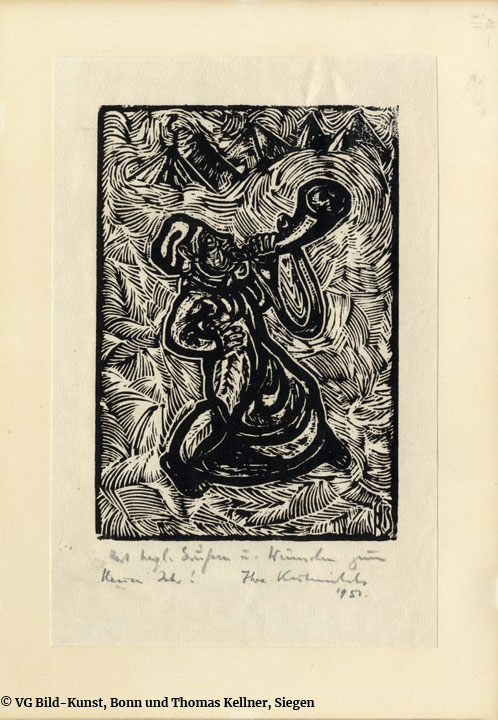To commemorate artist Hermann Kuhmichel

Life of Hermann Kuhmichel
Siegen. Hermann Kuhmichel is a well-known Siegerland artist of the 20th century. He was a gifted artist who not only addressed many themes in his works, but also had a great diversity of working materials to show.
Not much is said about his childhood. He came into the world on 4 March 1898, joining a family that already numbered nine. He later enjoyed various educations before being called up for war in 1914. He served at the front until 1920, when he was sent home because of a serious injury. There he worked as a forestry teacher until 1927. It was only during the years of the Weimar Republic that he decided to devote himself to his love of art and eventually decided to change his career.
He had always been enthusiastic about art, so it was not surprising that he enjoyed learning at various art colleges. In fact, he responded to his desire for artistic education by first studying at the Kunstgewerbeschule in Aachen, then attending the Werkkunstschule in Cologne and finally learning his profession at the Kunstakademie in Düsseldorf. Kuhmichel decided to open a studio in Siegen shortly after beginning his career, in 1929. There, it didn’t take long until he was offered large commissions, which confirmed that he made the right choice regarding his career.
With the beginning of the Nazi regime, numerous artists were forbidden to pursue their professional activities, and this entailed severe consequences and worries. Kuhmichel had to watch his colleague Minkenberg being dismissed from his post at the Kunstgewerbeschule in Aachen in 1934. The school at which Kuhmichel had studied was closed down because the artists' work had been "degenerate". Kuhmichel himself was also hit by such defamation. Some of his works were reported as "degenerate art", which had severe consequences. He was blamed for his works and some of them were taken away from him. For a time he was even threatened with a ban on exhibiting and creating. Nevertheless, he received state commissions during this time, which enabled him to feed his family. Among these were mainly war propaganda works. Theobald Meiswinkel even described him as an artist who had put his "creativity emphatically in the service of the times" (1942).
The Second World War had a great impact on Kuhmichel's art. Immediately afterwards, he began to produce works that reflected what had happened and perhaps gave him the opportunity to come to terms with it. Eventually, he turned to subjects that had little to do with the war and more to do with everyday life. He continued with his works of hard-working people, but slowly the religious-philosophical theme worked its way out until he turned to the everyday, such as the economic miracle.
He had found his studio destroyed after the war. It was not until 1953 that he was able to move into his own new studio. The artistic phase that followed was perceived by many as rich in creative energy and creativity. His artistic recognition grew steadily, so that countless of his works can still be found in Siegerland today.
His role during the Nazi regime became a public issue again in the 1980s and was widely discussed. More and more attempts were made to rehabilitate his works and his image. This was done through exhibitions, and photographs of works in public spaces. A street was named after him in Kreuztal.
Hermann Kuhmichel died on 21 September 1965. Until his death, Kuhmichel gave courses that enabled many to discover their enthusiasm for art. This art group is called the "Kuhmichel Group".








